Managing Water Challenges, Presentation by David Lipton, First Deputy Managing Director, IMF
June 11, 2015
Presentation by David LiptonFirst Deputy Managing Director, IMF
Launch of IMF Study on Managing Water Challenges and Policy Instruments
World Resources Institute
Washington, D.C.
June 8, 2015
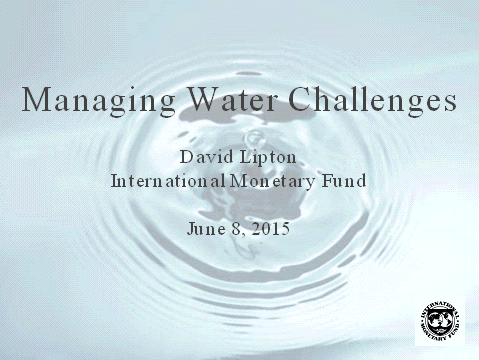
• I’d like to start by thanking the World Resources Institute for hosting this event and to also thank your staff for helping us during the process of writing this paper. The Aqueduct risk-mapping tool, in particular, was of great assistance during the course of our research.
• I’m sure some of you did a double take and thought it might be a typo when you saw the letters IMF as the authoring institution on a paper on water challenges. In fact, topics such as energy subsidies and climate change can impact macroeconomic stability and growth. In cases where these issues are macro-critical, the IMF can play an important role in helping to shape policy.
• What I am going to talk about today is not something new to you. For years many have argued for “getting prices right” to better manage water, but there has not been enough listening. This IMF study hopes to raise awareness of growing water challenges and shine a light on the need for proper water pricing.
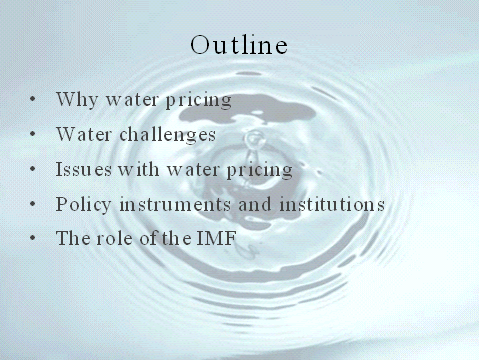
• I’ll touch on five key areas in my presentation.
• The first is: why focus on water pricing?
• The second is the challenges presented by water.
• The third is issues with water pricing.
• The fourth is policy instruments and institutions to manage water challenges.
• And, finally, the role of the IMF.
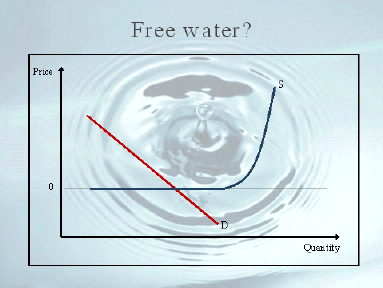
• One of the first things I learned in Introductory Economics is the diamond and water paradox. How can it be, your professor asks, that water is free even though life cannot exist without it, while diamonds are expensive although no one dies for a lack of diamonds?
• Of course, water can be free if its supply is abundant relative to demand, even at a zero price. However, it is increasingly evident that growing water use and limited water supply in many parts of the world means that this chart does not apply universally, probably not even broadly. Water should have a positive price where there is competing demand for finite supply.
• Many governments are reluctant to price water like other goods. Some view water access as a right, or there is just a general presumption it should not be priced. There is also a well-intentioned, but ultimately misguided idea that by not charging for water you help poor people.
• When you don’t get prices right for water, you are bound to end up with misallocation today and misallocation tomorrow. Misallocation today can take the form of thirst in population, low agricultural productivity, or worse, poor sanitation, disease, and malnourishment. Misallocation tomorrow can take the form of inadequate investment in infrastructure and the technologies to meet future water needs and ensure water security.
• All these are important enough to lead to macroeconomic and growth underperformance in economies. The need to “get prices right” can be seen from country experiences around the globe.
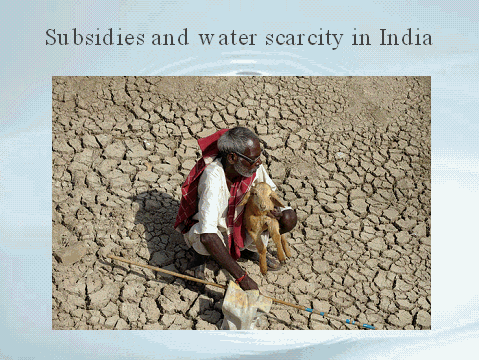
• Let me start with India, a case where under-pricing of water and inputs is contributing to scarcity today and long-term problems that will be hard to solve.
• The green revolution in the 1960s was a major boost to agricultural productivity, through the introduction of high-yield crop varieties and application of modern agricultural techniques. The green revolution also depended upon adequate water supply through a number of minor, major and multipurpose irrigation projects to reduce the dependence of farmers on rainfall.
• But many policy mistakes followed in the years since then—including extensive input subsidies that encouraged “too much of a good thing.” Water-related subsidies (through lower prices of diesel and free electricity for irrigation pumps) have led to widespread overuse of underground aquifers and increased salinity of soils. Free or heavily subsidized electricity for irrigation also plays havoc with the finances of electricity utilities, which have become a major fiscal burden. The so called “bread basket” states of Punjab and Haryana in India are experiencing groundwater use well in excess of net availability—leading to a severe depletion of the water table. And this now risks nearly undoing all the productivity gains from the green revolution.

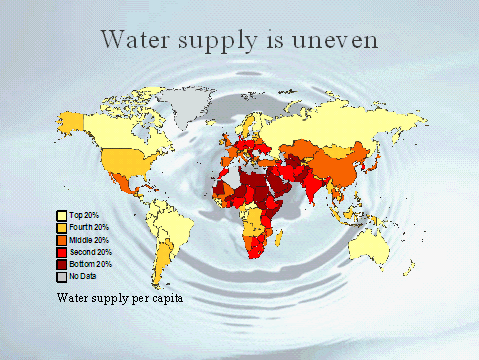
• It is not the case that supply exceeds demand at a zero price, as in our chart, across most of the world.
• Although water covers approximately 70 percent of the Earth’s surface, only a small fraction of it is available for human use.
• While technology gains in some advanced countries have helped to ease freshwater supply constraints, these technologies remain expensive.
• Additionally, the global stock of freshwater is also unevenly distributed. Over 60 percent of the usable freshwater supply is found in just 10 countries.
• For example, on a per capita basis, freshwater available in the Middle East and North Africa is only a tiny fraction of that in Latin America.

• Water supply is also subject to variation. Highly variable water supply adds to the challenge of ensuring that water is available when it is needed.
• Drawing from the WRI’s Aqueduct database, this chart plots a simple average of four supply variability indexes against the storage capacity index.
• These four country-level indicators measure different aspects of water variability: interannual, seasonal, flood occurrence, and drought severity. Out of 179 countries and territories, 119 have at least one aspect of high variability. And all but one (South Korea) of the 34 countries that are vulnerable to high water variability in at least two aspects are developing countries.
• Many countries that face high water variability do not invest enough in increasing water supply resilience and have low storage capacity. This is particularly so for low-income countries such as Eritrea and Niger.

• Water resources become scarce if water supply is insufficient relative to demand (what we will call water stress) or if a population has limited access to safe drinking water and sanitation, due to poor infrastructure or weak institutions.
• This chart plots countries along the two dimensions of water scarcity: water stress or the horizontal axis and water/sanitation access level on the vertical. In other words it looks at physical water scarcity, water use relative to water supply, and economic water scarcity, lack of access to water.
• Countries face different water challenges. Many countries in the Middle East already experience high water stress, in part reflecting their arid climates. Many low-income countries, notably sub-Saharan African countries, are in the group of “low stress, low access,” which suggests that they may move into high stress groups as access to water improves.
• Sixteen countries, all of which are emerging market or developing countries, face the dual challenge of improving water access and managing already high water stress.
• Advanced countries are not spared either. Even in countries where water stress is low at the country level, pockets of high stress can exist within the country. This is shown by high regional water variability, marked in red dots. The U.S. is a case in point.
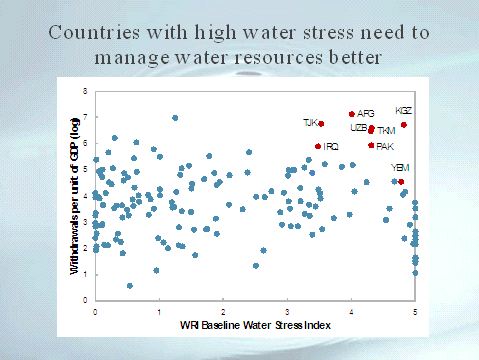
• Intuitively, countries endowed with more water resources should use more water for economic activities, reflecting their “comparative advantages.” But, as this chart shows, water stress and supply constraints do not seem to lead countries to economize on water use.
• Quite strikingly, some of the most water-stressed countries in the Middle East and Central Asia have among the highest water use per unit of GDP. This could be an indication of inefficient management of water resources, including poor pricing structures.
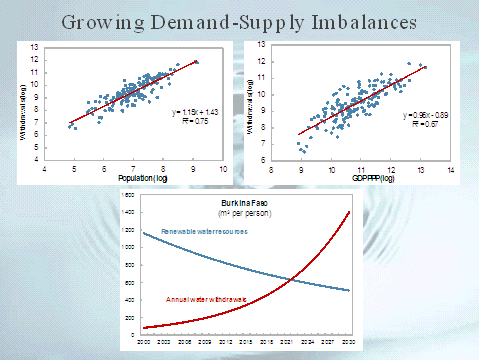
• Water use can be expected to grow in line with population and income growth, particularly in developing countries. At the same time supply may not be easily increased. This will contribute to growing water demand and supply imbalances.
• For example, per capita water use in Burkina Faso could outstrip supply in roughly 10 years.
• The increasing competition for water resources calls for policy instruments to signal scarcity. This will help rationalize water use and promote investment and innovation.

• At water pricing. The IMF paper estimated water subsidies provided through public utilities. This serves as a microcosm of the broader problem of under-pricing of water.
• Public water utilities in many countries charge a price that is just a fraction of the cost recovery level. In other words: subsidies. These can be very large in some regions. Our estimates suggest that, globally, water subsidies totaled about US$456 billion or about 0.6 percent of global GDP, in 2012.
• As we see from this chart, in countries of the Middle East and North Africa, Developing Asia and Commonwealth of Independent States, subsidies amounted to 1½ percent of GDP in 2012 overall. In some countries, subsidies are as high as 5 percent of GDP.
• So, water subsidies can be a substantial fiscal burden and can crowd out other needed spending. But more troubling, they are often not reported transparently, nor appropriately funded. That, in turn, leads to lack of maintenance and underinvestment in needed infrastructure.
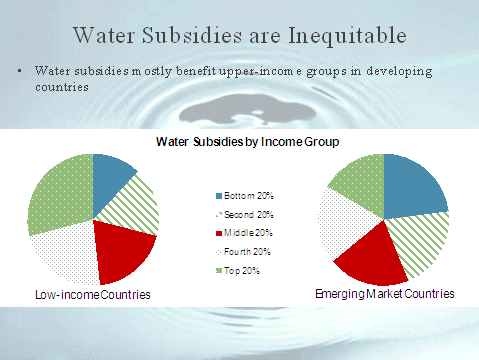
• Beyond the fiscal burden, water subsidies are inequitable. Water subsidies often cover uses beyond needs and extend to those with sufficient income to pay the costs of provision.
• In fact, water subsidies mostly benefit upper-income groups in developing countries as the poor have often limited or no access to water and subsidies are conveyed in proportion to water usage, which requires access. Here we see that in selected low-income economies, the poorest 20 percent of the population received on average less than 12 percent of subsidies, while the richest received almost 30 percent of the benefits.
• Subsidies also appear to be less inequitable in emerging market economies, though averages mask important differences across countries. For example, the poorest receive about 11 percent of subsidies in India, while in Chile they receive 36 percent.
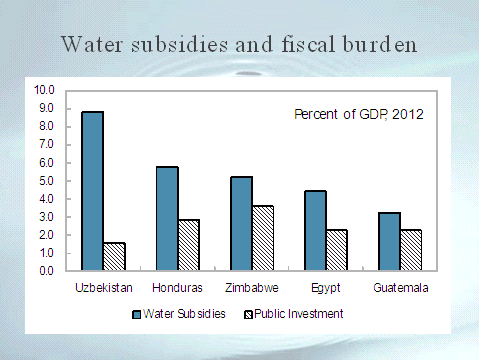
• Under-pricing of water results in fiscal subsidies and imposes large fiscal burdens. In some countries, water subsidies are found to exceed total public investment spending, signaling a possible crowding out of priority expenditures.

• How to address the challenges that I just discussed? It is important to note that some naturally water-deficient countries, such as Singapore and Burkina Faso, have been able to overcome water challenges as a result of sound policies and institutions.
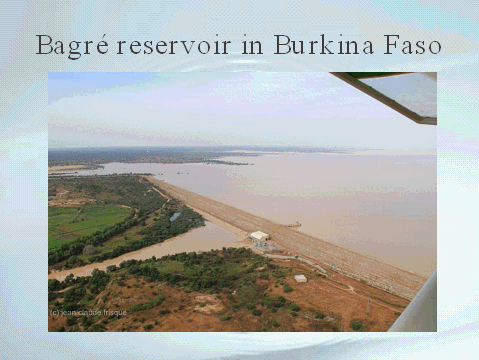
• Burkina Faso introduced a progressive tariff grid for drinking water, based on the volume of use, with the higher tier users subsidizing the lowest tier, as well as part of sanitation activities. The public water utility has recovery rates of 97 percent and low debt ratios and realizes annual profits.
• Despite its scarce endowment of water and highly variable rainfall, access to drinking water has doubled over the past two decades, catalyzed by the water pricing reform.
• Since the mid-2000s Burkina Faso has also invested extensively in water collection and storage. One unique innovation is the Bagré “growth pole.” Thirty years ago the riverbanks of Bagré supported only subsistence farming. Then the government created a large reservoir by constructing a dam on the Nakanabe River and adopted a strategy to encourage economic activity in the area. Today, the river and surrounding area support a wide array of agricultural production, a fish hatchery, eco-tourism, and electricity generation, all of which attract investment from the private sector and generate employment.
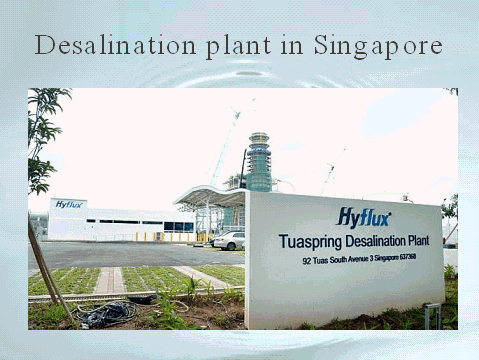
• Singapore is a country with high water stress, but it managed to overcome water challenges through diversification of water supply sources, demand management tools, research and development (R&D), and broad public support.
• For decades, Singapore has invested in research and development of new, revolutionary technologies. Given the emphasis put on water-related R&D by the government, Singapore has emerged as an international hub for water-related research. Today, the country is home to over 70 local and international water companies and more than 20 research and development centers.
• Singapore also employs a pricing policy that aims at discouraging excessive use of water and recovering costs to the fullest extent possible. Unlike in many other countries, both domestic and non-domestic users face the same base tariff, with no cross-subsidization of households by industrial and commercial users. Moreover, beyond a certain level of consumption, households face an additional surcharge. There is no subsidized “basic” consumption; instead the government provides targeted help for low-income families. Consumers are also charged a flat water-borne fee (to offset costs of treating used water and maintaining public sewage system; for non-domestic users this fee doubles); a flat sanitary appliance fee (charged per sanitary fitting); and a progressive water conservation tax (supposed to reflect the marginal cost of the “next,” alternative water sources, including the R&D costs).
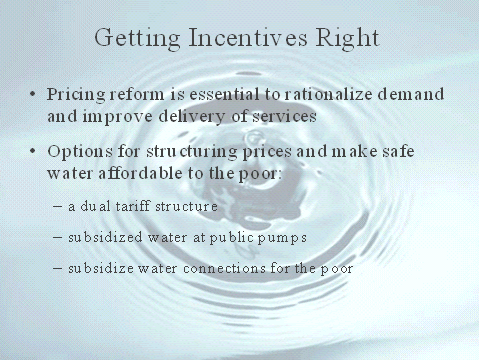
• Let me turn to the key messages from the IMF study.
• Water pricing reform is essential to rationalize demand for water and to improve the delivery of services and unlock further water supply. Pricing should be done in a way that achieves cost-recovery, with costs meant to include not only the costs of delivering water, but also costs of maintenance and infrastructure investment.
• These reforms also should be designed in a way that ensures water access to the poor and vulnerable.
• One option is to establish a dual tariff structure that provides a certain amount of water at subsidized prices to everyone and charges a higher tariff beyond that level. This takes care of the affordability, but requires high levels of access by the poor to the public water network.
• A second is to subsidize water at public pumps. This type of subsidy is self-targeted, especially if pumps are only in low-income neighborhoods.
• Or a third option is to subsidize water connections for the poor, which would improve their access to water at prices below those charged by private vendors.
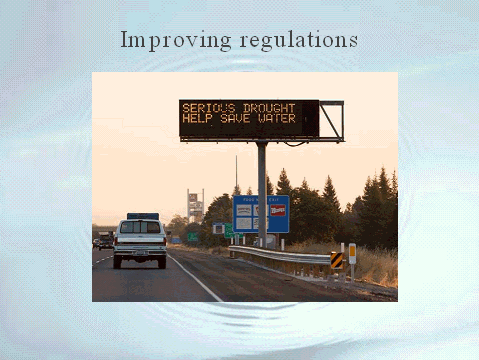
• Regulatory reforms can also help rationalize demand for water, allocate water to its most productive uses, and address externalities associated with water use, such as extraction of non-renewable sources of ground water. Since most of the water is extracted directly by users from the ground, rather than purchased from public water utilities, a strengthening of property rights and regulations can help promote the efficient use of water.
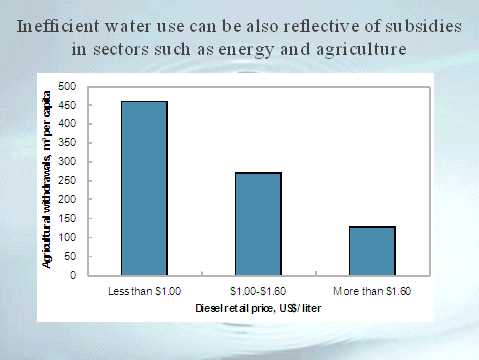
• Achieving greater efficiency in water consumption requires reforms of other policies that drive water use—directly or indirectly—in other sectors such as agriculture or energy.
• For example, subsidized energy prices create disincentives for efficient water use in agriculture, which accounts for 70 percent of all water withdrawn. As shown by this chart, countries with low prices for diesel fuel, for example, tend to have greater withdrawal of water for agriculture use.
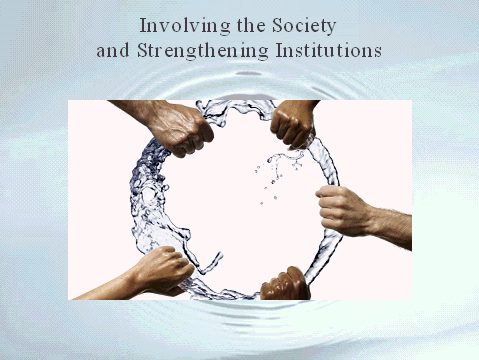
• Last but not least, our country studies show that reforms are much more likely to succeed if there is greater public awareness of water challenges and water management is left to strong and independent institutions.

• Finally, let me say a few words on how the IMF can help.
• The IMF can ensure that countries’ macroeconomic policies are conducive to sound water management.
• First, in collaboration with other institutions such as the World Bank, the IMF can help by assessing the impact of water challenges on growth and macro-stability.
• The IMF can encourage macroeconomic policies to “get incentives right,” such as replacing perverse energy and water subsidies with targeted social support.
• By designing macroeconomic policies that create fiscal space [use a simpler term for the audience] or catalyze financing, the IMF can help countries increase water-related investment to improve access to water and sanitation and strengthen resilience to supply variability.
• We can advise countries on strengthening their public investment management systems, contributing to adequate maintenance spending and better prioritization of public investment.
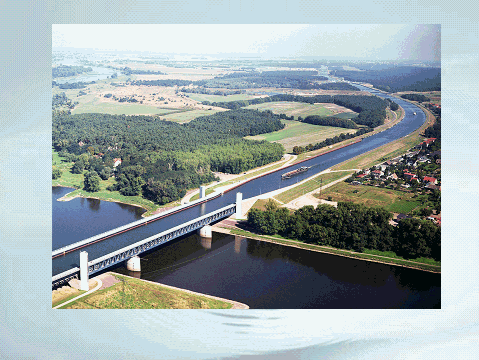
• To finish, I would like to reiterate three main findings from our work:
• First, it is important to get incentives right, notably by reforming water pricing. This can help rationalize water use, promote needed investment, and protect the poor.
• Secondly, the most desirable approach to reform water pricing will vary country by country, depending on the access of the poor to the existing water network and administrative capacity.
• Finally, achieving sound water management requires a holistic approach that goes beyond the water sector itself. For example, excessive pumping of groundwater can be discouraged by improving regulations and replacing energy subsidies with targeted social assistance.
• Now, I’d be happy to take any questions you may have.
IMF COMMUNICATIONS DEPARTMENT
| Public Affairs | Media Relations | |||
|---|---|---|---|---|
| E-mail: | publicaffairs@imf.org | E-mail: | media@imf.org | |
| Fax: | 202-623-6220 | Phone: | 202-623-7100 | |







